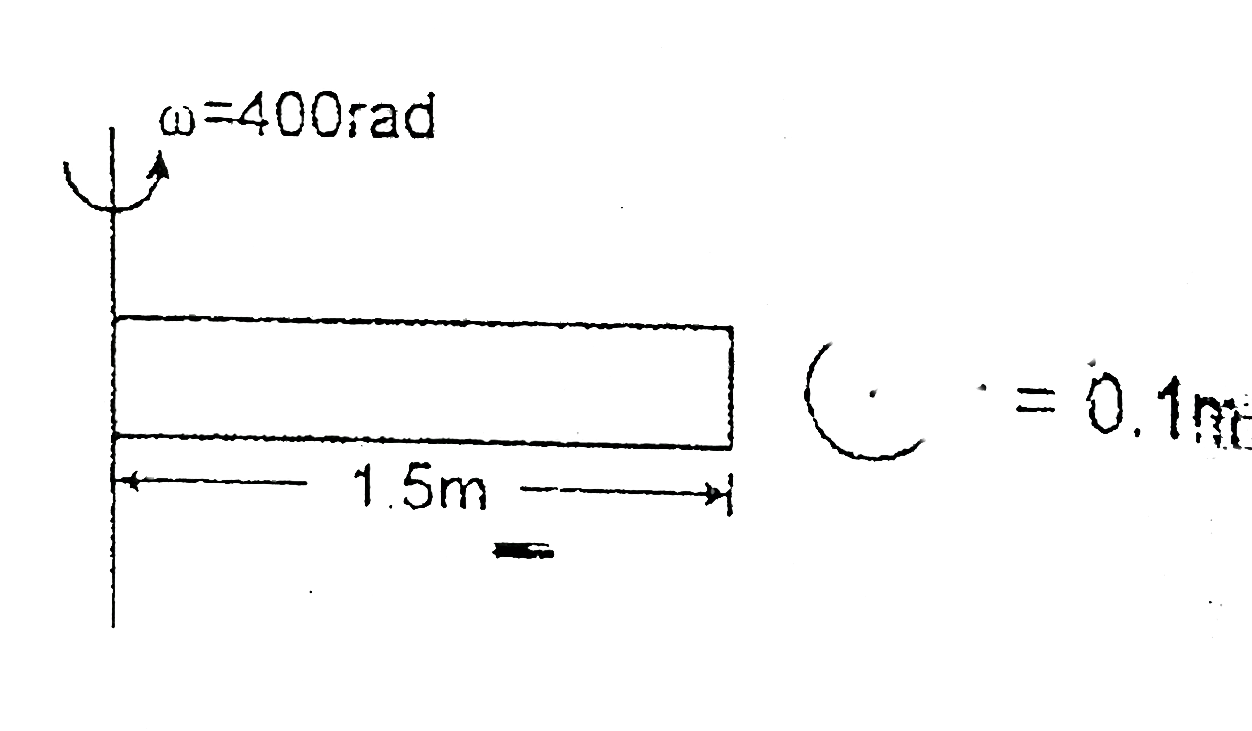A block of mass 4 kg is suspended from the ceiling with the help of a steel wire of radius 2mm and negligible mass. Find the stress in the wire. (g=π2) (A) 4.0×106N/m2 (B) 3.14×106N/m2 (C) 3×105N/m2 (D) 2.0×106N/m2
To find the stress in the steel wire, we will follow these steps:
Step 1: Calculate the Weight of the Block
The weight W of the block can be calculated using the formula:
W=m⋅g
where m is the mass of the block and g is the acceleration due to gravity. Given m=4kg and g=π2.
Substituting the values:
W=4kg⋅π2
Step 2: Determine the Tension in the Wire
Since the block is in equilibrium (not moving), the tension T in the wire is equal to the weight of the block:
T=W=4⋅π2
Step 3: Calculate the Cross-Sectional Area of the Wire
The cross-sectional area A of the wire can be calculated using the formula for the area of a circle:
A=πr2
where r is the radius of the wire. Given r=2mm=2×10−3m.
Substituting the radius:
A=π(2×10−3)2=π⋅4×10−6=4π×10−6m2
Step 4: Calculate the Stress in the Wire
Stress σ is defined as the force (tension) per unit area:
σ=TA
Substituting the values of T and A:
σ=4π24π×10−6=π2π×10−6=π10−6=π×106N/m2
Step 5: Substitute the Value of π
Using π≈3.14:
σ≈3.14×106N/m2
Conclusion
Thus, the stress in the wire is approximately:
σ≈3.14×106N/m2
The correct answer is (B) 3.14×106N/m2.
---
The weight W of the block can be calculated using the formula:
W=m⋅g
where m is the mass of the block and g is the acceleration due to gravity. Given m=4kg and g=π2.
W=4kg⋅π2
Since the block is in equilibrium (not moving), the tension T in the wire is equal to the weight of the block:
T=W=4⋅π2
The cross-sectional area A of the wire can be calculated using the formula for the area of a circle:
A=πr2
where r is the radius of the wire. Given r=2mm=2×10−3m.
A=π(2×10−3)2=π⋅4×10−6=4π×10−6m2
Stress σ is defined as the force (tension) per unit area:
σ=TA
Substituting the values of T and A:
σ=4π24π×10−6=π2π×10−6=π10−6=π×106N/m2
Using π≈3.14:
σ≈3.14×106N/m2
Thus, the stress in the wire is approximately:
σ≈3.14×106N/m2
Similar Questions
The adjacent graph shows the extra extension (Δx) of a wire of length 1m suspended from the top of a roof at one end with an extera load Δw connected to the other end If the cross sectional area of the wire is 10−5m2 calculate the Young's modulus of the meterial of the wire
(A) 2×1011N/m2 (B) 2×10−11N/m2 (c) 3×10913)N/m3 (D) 2×1016N/m2
 .
.
View SolutionFind the greatest length of steel wire that can hang vertically without breaking. Breaking stress of steel =8.0×108N/m2. Density of steel =8.0×103kg/m3. Take g=10m/s2.
View SolutionHardness of water is 200 ppm. The normality and molarity of CaCO3 in the water is
(a). 2×10−6(N,2×10−6M
(b). 4×10−2N,2×10−2M
(c). 4×10−3N,2×10−3M
(d). 4×10−1N,2×10−1M
View SolutionA lift of mass 1000 kg is suspended by steel wire of maximum safe stress 1.4×108N/m2. Find the minimum diameter of the wire, if the maximum acceleration of the lift is 1.2ms−2
View Solution(a) A wire 4m long and 0.3 mm, calculate the potential energy stored in the wire.
Young's modulus for the material of wire is 2.0×1011N/m2.
View SolutionThe density of the material of a wire used in sonometer is 75×10−2kg/m3. If the stress on the wire is 3.0×104N/m2, the speed of transverse wave in the wire will be
View SolutionA body of mass 3.14kg is suspended from one end of a wire of length 10m. The radius of cross-section of the wire is changing uniformly from 5×10−4m at the top (i.e. point of suspension) to 9.8×10−4m at the bottom . Young's modulus of elasticity is 2×1011N/m2. The change in length of the wire is
View SolutionGiven Y=2×1011N/m2,ρ=104kg/m3
Find out elongation in rod.

View SolutionConsider a wire of length 0.1 m with an area fo cross section 1mm2 connected to 5V. Find the current flowing through the metallic wire where μ=5×10−6m2
V1s−1,e=1.6×10−19C,andn=8×1028m−3.
View SolutionA steel wire 2mm in diameter is just stretched between two rigid walls at 20°C. If the temperature falls to 10°C, find the tension in the wire. Linear coefficient of expansion of steel = 11×10−6/kandY=2×1011N/m2
View Solution
